"WORLD LONGEST"
Mencari benda-benda 'buatan manusia' yang terpanjang di dunia.
The longest BRIDGE in the world
China has opened the world's longest cross-sea bridge - which stretches five miles further than the distance between Dover and Calais. The Jiaozhou Bay bridge is 26.4 miles long and links China's eastern port city of Qingdao to the offshore island Huangdao. The road bridge, which is 110ft wide and is the longest of its kind, cost nearly £1billion to build.
That structure features two bridges running side by side and is 23.87 miles long. The three-way Qingdao Haiwan bridge is 174 times longer than London's Tower Bridge, spanning the River Thames, but cuts only 19 miles off the drive from Qingdao to Huangdao. Two separate groups of workers have been building it from different ends of the structure since 2006. After linking the two ends of the bridge on December 22, one engineer said: 'The computer models and calculations are all very well but you can't relax until the two sides are bolted together.
The engineering feat will only hold the record as the longest sea bridgefor a few years - it will be beaten by another Chinese bridge in the next decade. Last December officials announced workers had begun constructing a bridge to link southern Guangdong province with Hong Kong and Macau. Set to be completed in 2016, officials said the £6.5billion bridge will span nearly 30 miles.
It will be designed to cope with earthquakes up to magnitude 8.0, strong typhoons and the impact of a 300,000 tonne vessel. But both structures will still be dwarfed by the longest bridge in the world, also in China. The Danyang-Kunshan Grand Bridge is an astonishing 102 miles in length
The longest ENGLISH WORD in the officially used dictionary
The longest word in any of the major English language dictionaries is;
a word that refers to a lung disease contracted from the inhalation of very fine silica particles, specifically from a volcano; medically, it is the same as silicious. The word was deliberately coined to be the longest word in English, and has since been used in a close approximation of its originally intended meaning, lending at least some degree of validity to its claim.
The Oxford English dictionary contains "PSEUDOPSEUDOHYPOPARATHYROIDISM" (30 letters).
The longest non-technical word in major dictionaries is "FLOCCINAUCINIHILIPILIFICATION" at 29 letters. Consisting of a series of Latin words meaning "nothing" and defined as "the act of estimating something as worthless"; its usage has been recorded as far back as 1741
The longest RAILWAY TUNNEL in the world
The longest railway tunnel was completed on 15 October 2010 in Switzerland when the last two meters of rock were drilled through. After 14 years of construction the 57 km (34 miles) of the Gotthard Base Tunnel in the Swiss Alps was finally completed when a giant drilling machine nicknamed Sissi cut through the last slice of rock to connect both ends.
After the final breakthrough, 50 miners carrying flags reprsenting the regions of Switzerland involved in the construction walked through the opening- Rahel Probst of AlpTransit Gotthard
The tunnel is just over 4 km longer than the Seikan rail tunnel in Japan, which at 53.9 km had previously been the longest rail tunnel in the world.
Completion of the Gotthard Base Tunnel will cut the travel time between Zurich and Milan in Italy by 60 minutes to two-and-a-half hours and provide an easier and more economic route for heavy freight trains. The tunnel which is in fact composed of two single-track tunnels, cost $10.6 billion (£6.6 billion).
Since the first preparations for the tunnel were laid in 1996, over 2,500 workers have taken part in its building according to AlpTransit Gotthard, the company constructing the tunnel. It is due to be operational by the end of 2017.
Freight traffic in the entire Alpine region will grow by as much as 75 percent by 2010, according to a study by the EU Commission. And according to AlpTransit Gotthard, the flatter route of the rail link "will allow fast, economical freight transportation.
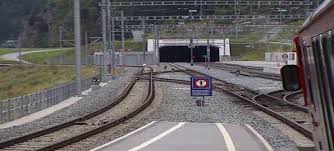

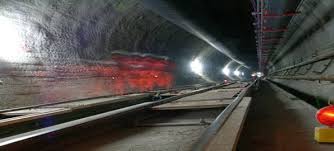
The longest RAILWAY LINE in the world
The world's longest railway, the Trans-Siberian Railway in Russia, is 5,777 miles (9,297 kilometers) long. It runs from Moscow to Vladivostok. If the auxiliary route to Nakhodka is included, the distance becomes 5,865 miles (9,436 kilometers). The Trans-Siberian Railway was opened in sections. The first train transporting goods reached Irkutsk on August 27, 1898.
The Baikal-Amur Northern Main Line, which began operating in 1938, shortens the distance from Moscow to Vladivostok by about 310 miles (500 kilometers). The journey takes approximately 7 days, 2 hours, and crosses 7 time zones. There are 9 tunnels, 139 large bridges or viaducts (bridge carrying a railroad over a valley), and 3,762 smaller bridges on the whole route. Nearly the entire line is electrified.
In comparison, the first American transcontinental railroad, completed on May 10, 1869, is 1,780 miles (2,864 kilometers) long. The Central Pacific Railroad was built eastward from Sacramento, California, and the Union Pacific Railroad was built westward from Omaha, Nebraska. The two lines were connected at Promontory Point, Utah.
Sources: Guinness Book of Records 1992, p. 378; Marshall, John.The Guinness Railway Book, pp. 62-64; McNeil, Ian. An Encyclopedia of the History of Technology, p. 574; "Union Pacific Railroad Company."Encyclopaedia Britannica CD 97.

Jay Ohrberg (from Burnbank, California) designed his 100 feet monster limo himself and now hires it out through his car hire company. The limo has 26 wheels and can be driven rigidly or adjusted to bend in the middle around corners. This incredible car is currently in the Guinness Book of World Records as the longest car in the world and even has two driver's compartments – one at each end – to help with reversing.
The longest car in the world is better equipped than many Hollywood mansions, including luxuries like a large Jacuzzi tub, a sun deck, a helipad, a swimming pool (with a diving board of course), a king sized bed and a satellite dish, just to name a few.
The longest BUS in the world
.
Zhejiang Young Man Vehicle Group launched the
25-meter-long super bus, about the size of a metro car, at the opening of
Busworld Asia 2007, a leading domestic bus and coach show in Shanghai. It is 13
meters longer than an ordinary bus and is the world's largest bus, according to
the manufacturer.
It takes about 35 steps to walk from the front to the back. It has five doors, 40 seats and can carry 300 people. The top speed is around 80 kilometers per hour.
Although the bus has a European style and a German MAN engine, the group designed the rest of the bus, said Zheng Han, marketing manager of Zhejiang Young Man Vehicle Group.
The testing drive from Zhejiang Province to Shanghai has showed that the top speed reached 82 kph. It is flexible when cornering.
The interior is designed for passenger convenience. It is easy for elderly and the disabled to enter as the first step is nearly level with the pavement. The bus also has room for wheelchairs.
The super bus together with other super-length buses will be put into service on Bus Rapid Transit in Beijing and Hangzhou in Zhejiang Province. The standard length of a BRT bus is 18 meters.
.

The longest WATER TUNNEL in the world
FAR beneath the feet of tramping millions, the longest tunnel of its kind in the world is nearing completion in New York City. Twenty miles in length, it will help distribute a billion gallons of water a day to New York homes and factories.
Officially, the shaft will be known as City Tunnel Number Two. City Tunnel Number One, completed fifteen years ago, has long been overtaxed. Hence 2,500 workmen have been toiling day and night for the last three years to construct the supplementary tunnel. To cut it through solid rock, they exploded 8.000,000 pounds of dynamite. Blasting went on twenty-four hours a day without disturbing surface dwellers, although the tunnel runs beneath one of the most densely populated areas in the world. A railroad train could be driven through the new fourteen-foot shaft.
Officially, the shaft will be known as City Tunnel Number Two. City Tunnel Number One, completed fifteen years ago, has long been overtaxed. Hence 2,500 workmen have been toiling day and night for the last three years to construct the supplementary tunnel. To cut it through solid rock, they exploded 8.000,000 pounds of dynamite. Blasting went on twenty-four hours a day without disturbing surface dwellers, although the tunnel runs beneath one of the most densely populated areas in the world. A railroad train could be driven through the new fourteen-foot shaft.

The longest CANAL in the world
The Grand Canal in China, also known as the Beijing-Hangzhou Grand Canal is the longest canal or artificial river in the world. Starting at Beijing, it passes throughTianjin and the provinces of Hebei, Shandong, Jiangsu and Zhejiang to the city of Hangzhou. The oldest parts of the canal date back to the 5th century BC, although the various sections were finally combined during the Sui Dynasty (581–618 CE).
The total length of the Grand Canal is 1,776 km (1,104 mi). Its greatest height is reached in the mountains of Shandong, at a summit of 42 m (138 ft). Ships in Chinese canals did not have trouble reaching higher elevations after the pound lock was invented in the 10th century, during the Song Dynasty (960–1279), by the government official and engineer Qiao Weiyo. The canal's size and grandeur won it the admiration of many throughout history, including the Japanese monk Ennin (794–864), the Persian historian Rashid al-Din (1247–1318), the Korean official Choe Bu (1454–1504) and the Italian missionary Matteo Ricci (1552–1610).
Historically, periodic flooding of the adjacent Yellow River threatened the safety and functioning of the canal. During wartime the high dikes of the Yellow River were sometimes deliberately broken in order to flood advancing enemy troops. This caused disaster and prolonged economic hardships. Despite temporary periods of desolation and disuse, the Grand Canal furthered an indigenous and growing economic market in China's urban centers through all the ages since the Sui period.

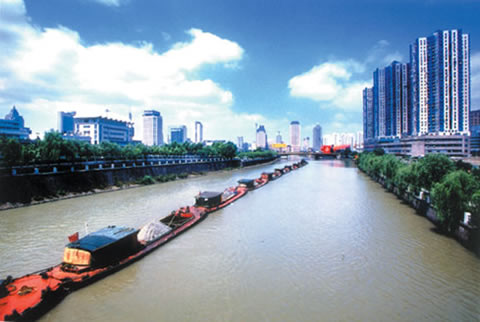
.
The longest and highest AQUEDUCT in the world
The Pontcysyllte Aqueduct is a navigable aqueduct that carries the Llangollen Canal over the valley of the River Dee in Wrexham in north east Wales. Completed in 1805, it is the longest and highest aqueduct in Britain, a Grade I Listed Building and a World Heritage Site.
When the bridge was built it linked the villages of Froncysyllte, at the southern end of the bridge in the Cysyllte township of Llangollen parish (from where it takes its name), and Trevor, at the northern end of the bridge in the Trevor Isaf township of Llangollen parish. Both townships were later transferred to Wrexham County Borough following local government reorganisation.
The name is in the Welsh language and means "Cysyllte Bridge". For most of its existence it was known as Pont y Cysyllte ("Bridge of Cysyllte"). Other translations such as "Bridge of the Junction" or "The Bridge that links" are modern, and incorrect, inventions, from the literal English translation of cysyllte being "junctions" or "links".
The aqueduct built by Thomas Telford and William Jessop, is 1,007 ft (307 m) long, 11 ft (3.4 m) wide and 5.25 ft (1.60 m) deep. It consists of a cast iron trough supported 126 ft (38 m) above the river on iron arched ribs carried on nineteen hollow masonry piers (pillars). Each span is 53 ft (16 m) wide. Despite considerable public scepticism, Telford was confident the construction method would work: he had previously built at least one cast iron trough aqueduct – the Longdon-on-Tern aqueduct on the Shrewsbury Canal, still visible in the middle of a field, though the canal was abandoned years ago. Part of what was originally called the Ellesmere Canal, it was one of the first major feats of civil engineering undertaken by Telford, by then a leading civil engineer, supervised by Jessop, the more experienced canal engineer. The iron was supplied byWilliam Hazledine from his foundries at Shrewsbury and nearby Cefn Mawr. It was opened on 26 November 1805, having taken around ten years to design and build at a total cost of £47,000. Adjusted for inflation this is equal to £2,930,000 as of 2011, however a structure of this type would cost more to build today due to other factors that didn't exist in the early 19th century such as higher wages (adjusted for inflation), safety measures, new regulations and taxes, financing fees and so on.
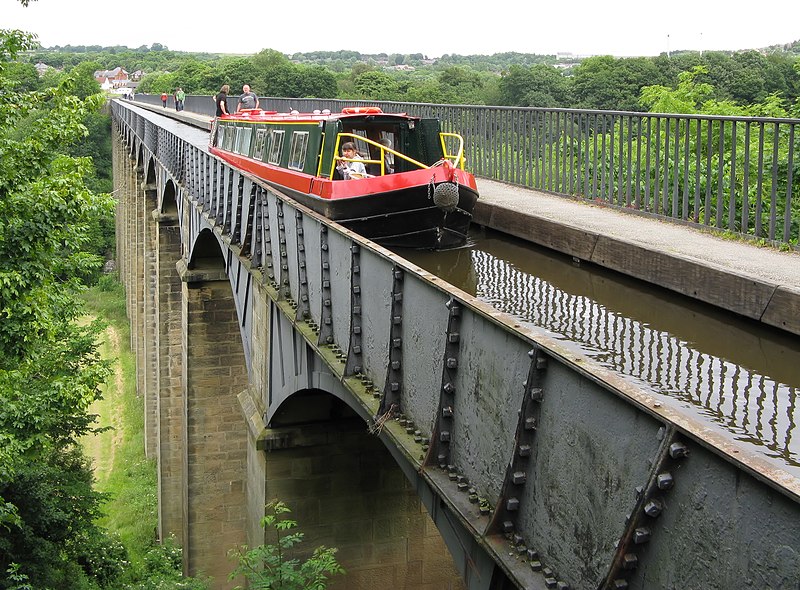

The longest SNIPER KILL 2.47km twice
The sniper is without doubt the most feared
combatant in any theater of war, the best of whom have an array of skills far
beyond simply being able to hit human targets at a distance. Snipers are the
most cost effective way of killing the enemy. Individual snipers routinely
account for more kills than entire battalions operating in the same place at
the same time, hit the target almost every time, and each bullet costs around
€2.
Whatsmore, snipers inflict a psychological terror on an enemy force that
restricts its ability to operate effectively – when elite snipers are
operating, they are invisible close up, and can strike from enormous distance,
so nowhere is safe. Indeed, an elite sniper's skills cannot be assessed with a
single measurement, so the “longest confirmed kill” record stands as the pseudo
world championship for military combat riflemen, and as of now there's a new
outright champion - using an Accuracy International L115A3,
British Corporal Craig Harrison killed two Taliban with consecutive shots at a
distance of 2.47 kilometres (8120 ft) in Helmand Province, Afghanistan last
November (2009). He then fired a third shot and hit the Taliban's PKM
machinegun in perhaps the most prodigious feat of marksmanship in military
history.

If you're wondering why it took so long for Harrison's
kill to be made public, (it was made last November and only became commonly
known in the last few days), understand that the publicity such a feat brings
may not necessarily be wanted, or healthy, particularly if you are still
"in theater". Harrison, who also survived a bullet passing through
his helmet, and two broken arms from an IED explosion, has now finished his
tour of duty and the story can be told.
The previous longest kill by Canadian Army Corporal Rob
Furlong had been spoken of by soldiers in hushed tones for five years before it
fell upon the ears of a reporter and become public knowledge and his name
revealed.
Harrison's feat is clearly the stuff of legend. The
previous record holder - Furlong - killed an al-Qaeda fighter from 2.43 km
during Operation Anaconda in Afghanistan in 2002. Furlong's shot was also
legendary - he made military history. There would not be any military
personnel in the world who would not be aware of Furlong's feat, and subsequently
Harrison's, and who would not measure that distance off towards the horizon
every day when they are in a combat zone. Harrison bested it TWICE – with
consecutive shots - then fired at and hit the much smaller target of the gun
the Taliban had been carrying. This is completely without parallel in military
history.
The rifle used by Furlong for his previous record was the
“Big Mac”, the McMillan Bros Tac-50 used by Canadian Special Forces and the
best .50 sniper rifle in the world..
Like Juan Manuel Fangio's car, Valentino Rossi's
motorcycle or Sir Donald Bradman's bat, a varying proportion of the glory
should also go to the champion's tool of choice – for snipers, the tool of
choice is critical, with Harrison using an Accuracy International L115A3
Long-Range rifle – a rifle originally developed by an Olympic gold medalist
target shooter which we wrote up two years ago in an article entitled - the
best sniper rifle in the world.
Craig Harrison's AI L115A3 cost the British Ministry of
Defence GBP23,000 (US$34,000), weighs 6.8 kilograms, and fires an 8.59mm bullet
which is heavier than the 7.62mm round of the previous L96 model and hence less
likely to be deflected over extremely long ranges. The L115A3 has a five-round
magazine, enabling the sniper to fire five rounds rapidly, though that would
almost never happen.
The L115A3 has an adjustable cheek piece to comfortably
align the shooter's eye with scope, and a folding stock so the rifle can be
more easily carried in a backpack.
It comes with an adjustable bi-pod stand and a suppressor
to reduce the flash and noise of the gun – once the enemy knows where a sniper
is, he too becomes a target – and a scope, in this case a 25 X magnification
S&B 5-25x56 day scope.
In extremely skilled hands, the L115A3 can hit a human-sized
target from 1400 meters (even at that range, it hits harder than a .44 Magnum
does in the same room), which means Harrison's shots put him in almost
superhuman company, as he almost doubled that distance, in combat, and killed a
first then second Taliban with consecutive shots, then took a third shot at the
PKM machinegun they unfortunate pair had been carrying with the intention of
disabling it – the gun was hit but damage could not be assessed.
Firing one bullet with that accuracy over more than a
mile and half, has never been recorded previously – Harrison did it three times
running. Though the bullet leaves the barrel at three times the speed of sound,
it still takes more than two and a half seconds to travel that distance. Though
the day was clear and still and in thin mountain air, Harrison still had to aim
six feet higher than the targets, and two feet to the left to allow for the
gentlest of breezes and bullet fall.
If the world of the military sniper is intriguing to you,
I can suggest an excellent new book on the subject written by Hans Halberstadt
entitled “Trigger Men” I just spent seven and a half hours listening to
the audio book though,
go figure, exactly the
same book is much cheaper in printed form, despite the cost of paper
and printing and binding and schlepping and postage.\
The book more than adequately kept my brain busy during
an international flight and covers the exploits of the modern sniper with hours
of anecdotes from Iraq and other recent wars. Halberstadt spoke with some of
the most revered names in sniping history to put the book together - names such
as Carlos
Hathcock II, who recorded 93 kills, including one of 2.29 kilometers
during the Vietnam war, and Sgt James
Gilliland, who also pulled off one of the
most remarkable kill shots ever recorded in a strong breeze.
The role of the sniper has changed, and this book explains why.
www.zigmag.com

This 6,643 foot (2,025 meter) sausage is perhaps a new record of Turija for 2009.

The longest SHIP in the world

With a capacity of 14,770 TEU and length of 397 meters (1,302 ft), the Emma Maersk is currently the longest functional ship and was once the largest container ship in the world. Owned by the A. P. Moller- Maersk Group, it was built at the Odense Steel Shipyard in Denmark in 2006. Emma Maersk’s sails around the ports of Ningbo, Xiamen, Hong Kong, Yantian, Algeciras, Rotterdam, Bremerhaven, and then back to Ningbo.
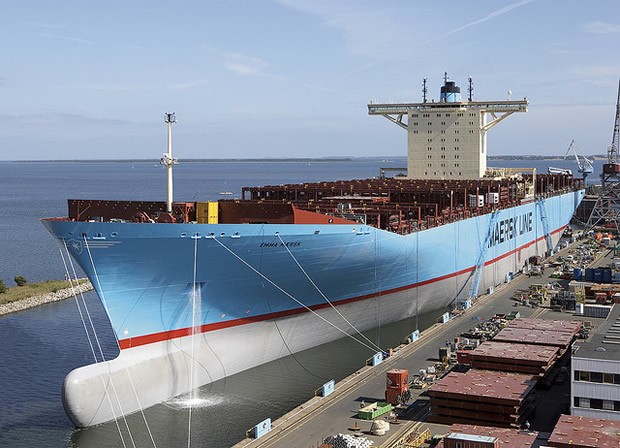
.jpg)
No comments:
Post a Comment